The NVIDIA GeForce GTX 780 Ti Review
by Ryan Smith on November 7, 2013 9:01 AM ESTOverclocking
Finally, let’s spend a bit of time looking at the overclocking prospects for the GTX 780 Ti. Although GTX 780 Ti is now the fastest GK110 part, based on what we've seen with GTX 780 and GTX Titan there should still be some headroom to play with. Meanwhile there will also be the matter of memory overclocking, as 7GHz GDDR5 on a 384-bit bus presents us with a new baseline that we haven't seen before.
| GeForce GTX 780 Ti Overclocking | ||||
| Stock | Overclocked | |||
| Core Clock | 876MHz | 1026MHz | ||
| Boost Clock | 928MHz | 1078MHz | ||
| Max Boost Clock | 1020MHz | 1169MHz | ||
| Memory Clock | 7GHz | 7.6GHz | ||
| Max Voltage | 1.187v | 1.187v | ||
Overall our overclock for the GTX 780 Ti is a bit on the low side compared to the other GTX 780 cards we’ve seen in the past, but not immensely so. With a GPU overclock of 150MHz, we’re able to push the base clock and maximum boost clocks ahead by 17% and 14% respectively, which should further extend NVIDIA’s performance lead by a similar amount.
Meanwhile the inability to unlock a higher boost bin through overvolting is somewhat disappointing, as this is the first time we’ve seen this happen. To be clear here GTX 780 Ti does support overvolting – our card offers up to another 75mV of voltage – however on closer examination our card doesn’t have a higher bin within reach; 75mV isn’t enough to reach the next validated bin. Apparently this is something that can happen with the way NVIDIA bins their chips and implements overvolting, though this the first time we’ve seen a card actually suffer from this. The end result is that it limits our ability to boost at the highest bins, as we’d normally have a bin or two unlocked to further increase the maximum boost clock.
As for memory overclocking, we were able to squeeze out a bit more out of our 7GHz GDDR5, pushing our memory clock 600MHz (9%) higher to 7.6GHz. Memory overclocking is always something of a roll of the dice, so it’s not clear here whether this is average or not for a GK110 setup with 7GHz GDDR5. Given the general drawbacks of a wider memory bus we wouldn’t be surprised if this was average, but at the same time in practice GK110 cards haven’t shown themselves to be as memory bandwidth limited as GK104 cards. So 9%, though a smaller gain than what we’ve seen on other cards, should still provide GTX 780 Ti with enough to keep the overclocked GPU well fed.
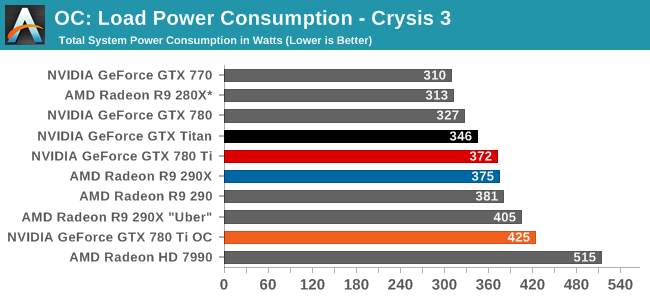
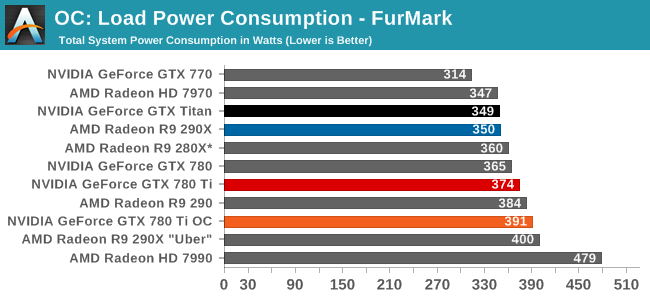
Starting as always with power, temperatures, and noise, we can see that overclocking GTX 780 Ti further increases its power consumption, and to roughly the same degree as what we’ve seen with GTX 780 and GTX Titan in the past. With a maximum TDP of just 106% (265W) the change isn’t so much that the card’s power limit has been significantly lifted – as indicated by FurMark – but rather raising the temperature limit virtually eliminates temperature throttling and as such allows the card to more frequently stay at its highest, most power hungry boost bins.
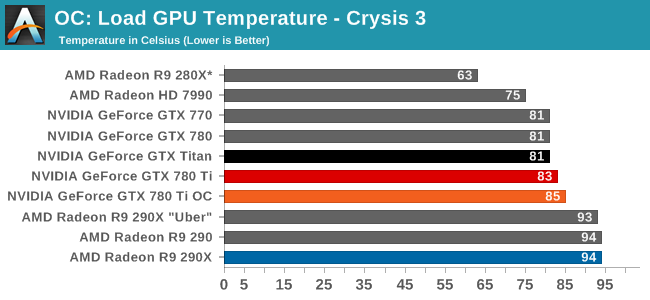

Despite the 95C temperature target we use for overclocking, the GTX 780 Ti finds its new equilibrium point at 85C. The fan will ramp up long before it allows us to get into the 90s.
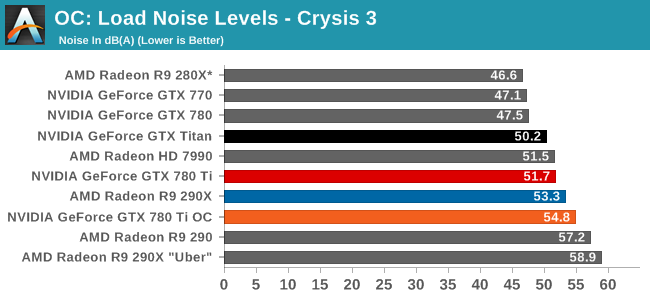
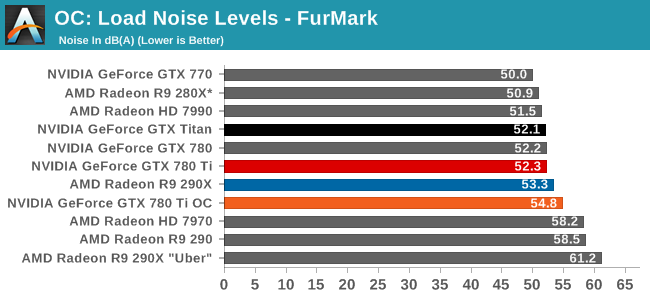
Given the power jump we saw with Crysis 3 the noise ramp up is surprisingly decent. A 3dB rise in noise is going to be noticeable, but even in these overclocked conditions it will avoid being an ear splitting change. To that end overclocking means we’re getting off of GK110’s standard noise efficiency curve just as it does for power, so the cost will almost always outpace the payoff on a relative basis.
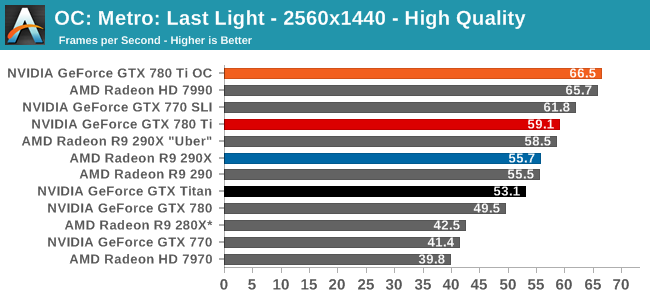
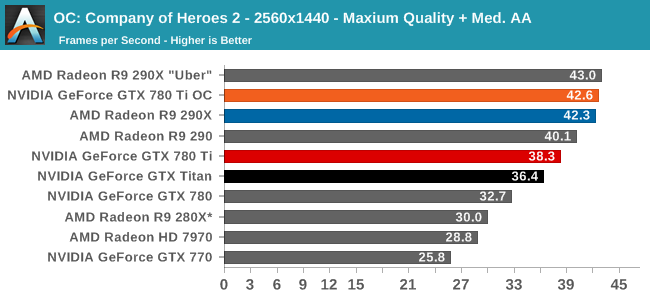
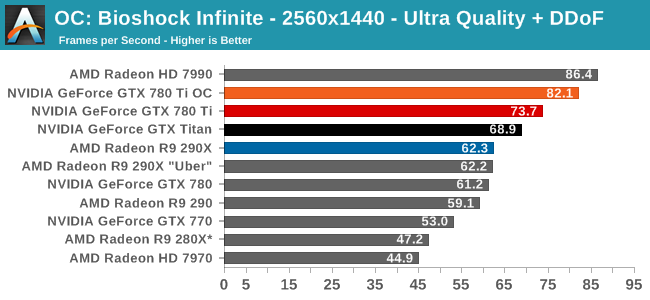
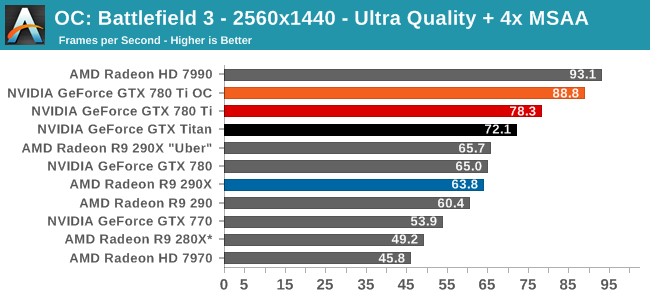
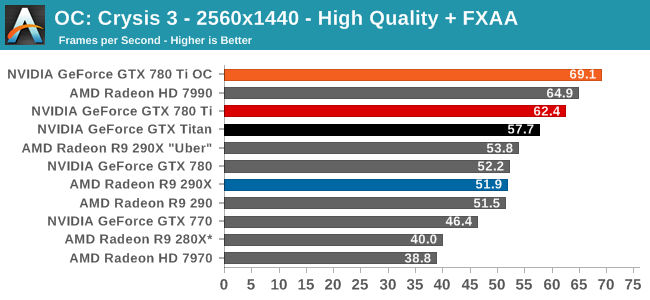
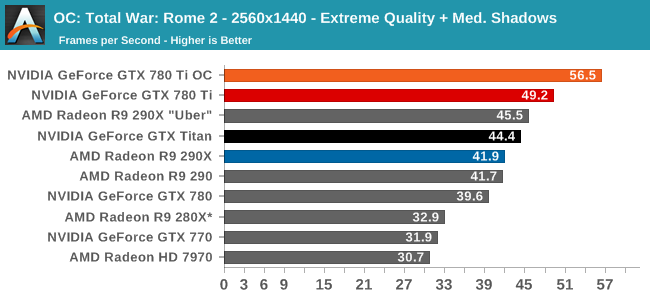
Finally, looking at gaming performance the the overall performance gains for overclocking are generally consistent. Between our 6 games we see a 10-14% performance increase, all in excess of the memory overclock and closely tracking the GPU overclock. GTX 780 Ti is already the fastest single-GPU card, so this only further improves its performance lead. But it does so while cutting into whatever is above it, be it the games where the stock 290X has a lead, or multi-GPU setups such as the 7990.










302 Comments
View All Comments
A5 - Thursday, November 7, 2013 - link
BF4 has a built-in benchmark too, but I have no idea how good it is. I'd guess they're waiting on a patch?If nothing else, there will be BF4 results if/when that Mantle update comes out.
IanCutress - Thursday, November 7, 2013 - link
BF4 has a built in benchmark tool? I can't find any reference to one.Ryan Smith - Thursday, November 7, 2013 - link
BF3 will ultimately get replaced with BF4 later this month. For the moment with all of the launches in the past few weeks, we haven't yet had the time to sit down and validate BF4, let alone collect all of the necessary data.1Angelreloaded - Thursday, November 7, 2013 - link
Hell man people run FEAR still as a benchmark because of how brutal it is against GPU/CPU/HDD.Bakes - Thursday, November 7, 2013 - link
I think it's better to wait until driver performance stabilizes for new applications before basing benchmarks on them. If you don't then early benchmark numbers become useless for comparison sake.TheJian - Thursday, November 7, 2013 - link
I would argue warhead needs to go. Servers for that game have been EMPTY for ages and ZERO people play it. You can ask to add BF4, but to remove BF3 given warhead is included (while claiming bf3 old) is ridiculous. How old is Warhead? 7-8 years? People still play BF3. A LOT of people. I would argue they need to start benchmarking based on game sales.Starcraft2, Diablo3, World of Warcraft Pandaria, COD Black ops 2, SplinterCell Blacklist, Assassins Creed 3 etc etc... IE, black ops 2 has over 5x the sales of Hitman Absolution. Which one should you be benchmarking?
Warhead...OLD.
Grid 2 .03 total sales for PC says vgchartz
StarCraft 2 5.2.mil units (just PC).
Which do you think should be benchmarked?
Even Crysis 3 only has .27mil units says vgchartz.
Diablo 3? ROFL...3.18mil for PC. So again, 11.5x Crysis 3.
Why are we not benchmarking games that are being sold in the MILLIONS of units?
WOW still has 7 million people playing and it can slow down a lot with tons of people doing raids etc.
TheinsanegamerN - Friday, November 8, 2013 - link
because any halfway decent machine can run WoW? they use the most demanding games to show how powerful the gpu really is. 5760x1080p with 4xMSAA gets 69 FPS with the 780ti.why benchmark hitman over black ops? simple, it is not what we call demanding.
they use demanding games. not the super popular games thatll run on hardware from 3 years ago.
powerarmour - Thursday, November 7, 2013 - link
Well, that time on the throne for the 290X lasted about as long as Ned Stark...Da W - Thursday, November 7, 2013 - link
I look at 4K gaming since i play in 3X1 eyefinity (being +/- 3.5K gaming).At these resolution i see an average of 1FPS lead for 780Ti over 290X. For 200$ more.
Power consumption is about the same.
And as far as temperature go, it's temperature AT THE CHIP level. Both cards will heat your room equally if they consume as much power.
The debate is really about the cooler, and Nvidia got an outright lead as far as cooling goes.
JDG1980 - Thursday, November 7, 2013 - link
It seems to me that both Nvidia and AMD are charging too much of a price premium for their top-end cards. The GTX 780 Ti isn't worth $200 more than the standard GTX 780, and the R9 290X isn't worth $150 more than the standard R9 290.For gamers who want a high-end product but don't want to unnecessarily waste money, it seems like the real competition is between the R9 290 ($399) and the GTX 780 ($499). At the moment the R9 290 has noise issues, but once non-reference cards become available (supposedly by the end of this month), AMD should hold a comfortable lead. That said, the Titan Cooler is indeed a really nice piece of industrial design, and I can see someone willing to pay a bit extra for it.